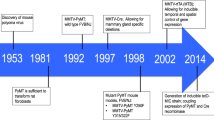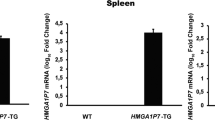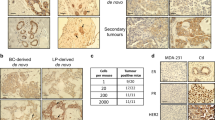Abstract
Certain strains of transgenic mice that express the rat neu oncogene (neuT) in mammary epithelial cells develop breast tumours at an average of 44 weeks of age. In this study, intraperitoneal injection of a monoclonal anti-receptor antibody specific for the rat neuT oncogene product dramatically affected tumour development in these transgenic mice in a dose-dependent manner. A significant proportion (50%) of mice, when injected with anti-receptor antibodies, did not develop tumours even after 90 weeks of age. The phosphotyrosine levels of the membrane fraction of breast tissues in the anti-receptor antibody-treated mice were almost completely abolished when a higher dose of antibodies was used. This study demonstrates, for the first time, that immunologic manipulation of an oncogene product can effectively prevent the development of tumours in a rodent transgenic model.
This is a preview of subscription content, access via your institution
Access options
Subscribe to this journal
Receive 12 print issues and online access
$209.00 per year
only $17.42 per issue
Buy this article
- Purchase on Springer Link
- Instant access to full article PDF
Prices may be subject to local taxes which are calculated during checkout
Similar content being viewed by others
References
Slamon, D.J. et al Studies of the HER-2/neu proto-oncogene in human breast and ovarian cancer. Science 244, 707–712. 1989.
Cohen, J.A. et al. Expression pattern of the neu (NGL) gene-encoded growth factor receptor protein (p185neu) in normal and transformed epithelial tissues of the digestive tract. Oncogene. 4, 81–88. 1989.
Kern, J.A. et al. p185neu expression in human lung adenocarcinomas predicts shortened survival. Cancer Res. 50, 5184–5187. 1990.
Zhau, H.E. et al. Amplification and expression of the c-erbB-2/neu proto-oncogene in human bladder cancer. Molec. Carcinog. 3, 254–257. 1990.
Williams, T.M., Weiner, D.B., Greene, M.I. & Maguire, H.C.J. Expression of c-erbB-2 in human pancreatic adenocarcinomas. Pathobiology 59, 46–52. 1991.
Bargmann, C.I., Hung, M.C. & Weinberg, R.A. Multiple independent activations of the neu oncogene by a point mutation altering the transmembrane domain of p185. Cell 45, 649–657. 1986.
Weiner, D.B. et al Linkage of tyrosine kinase activity with transforming ability of the p185neu 1oncoprotein. Oncogene 4, 1175–1183. 1989.
Di Fiore, P.P. et al. erbB-2is a potent oncogene when overexpressed in NIH/3T3 cells. Science 237, 178–182. 1987.
Chazin, V.R., Kaleko, M., Miller, A.D. & Slamon, D.J. Transformation mediated by the human HER-2 gene independent of the epidermal growth factor receptor. Oncogene. 7, 1859–1866. 1992.
Drebin, J.A., Link, V.C., Stern, D.F., Weinberg, R.A. & Greene, M.I. Down-modulation of an oncogene protein product and reversion of the transformed phe-notype by monoclonal antibodies. Cell 41, 697–706. 1985.
Drebin, J.A., Link, V.C., Weinberg, R.A. & Greene, M.I. Inhibition of tumor growth by a monoclonal antibody reactive with an oncogene-encoded tumor antigen. Proc. natn. Acad. Scl USA. 83, 9129–9133. 1986.
Drebin, J.A., Link, V.C. & Greene, M.I. Monoclonal antibodies specific for the neu oncogene product directly mediate anti-tumor effects in vivo. Oncogene. 2, 387–394. 1988.
Drebin, J.A., Link, V.C. & Greene, M.I. Monoclonal antibodies reactive with distinct domains of the neu oncogene-encoded pi85 molecule exert synergistic anti-tumor effects in vivo. Oncogene 2, 273–277. 1988.
Muller, W.J., Sinn, E., Pattengale, P.K., Wallace, R. & Leder, P. Single-step induction of mammary adenocarcinoma in transgenic mice bearing the activated c-neu oncogene. Cell 54, 105–115. 1988.
Bouchard, L., Lamarre, L., Tremblay, P.J. & Jolicoeur, P. Stochastic appearance of mammary tumors in transgenic mice carrying the MMTV/c-neu oncogene. Cell 57, 931–936. 1989.
Majors, J. & Varmus, H.E. A small region of the mouse mammary tumor virus long terminal repeat confers glucocorticoid hormone regulation on a linked heterologous gene. Proc. natn. Acad. Scl USA. 80, 5866–5870. 1983.
Bacus, S.S. et al. Tumor-inhibitory monoclonal antibodies to the HER-2/Neu receptor induce differentiation of human breast cancer cells. Cancer Res. 52, 2580–2589. 1992.
Slamon, D.J. et al Human breast cancer: Correlation of relapse and survival with amplification of the HER-2/neu oncogene. Science 235, 177–182. 1987.
Van de Vijver, M.J. et al. Neu-protein overexpression in breast cancer. Association with comedo-type ductal carcinoma in situ and limited prognostic value in stage II breast cancer. New Engl. J. Med. 319, 1239–1245. 1988.
Maguire, H.C.J. & Greene, M.I. Neu (C-ERB-2), a tumor marker in carcinoma of the female breast. Pathobiology. 58, 297–303. 1990.
Borg, A. et al HER-2/neu amplification predicts poor survival in node-positive breast cancer. Cancer Res. 50, 4332–4337. 1990.
Mooi, W.J. & Peterse, J.L. Progress in molecular biology of breast cancer. Eur. J. Cancer. 28, 623–625. 1992.
Leslie, K.O. & Howard, P. Oncogenes and antioncogenes in human breast carcinoma. Pathol. Annu. 27, 321–342. 1992.
Kokai, Y. et al Synergistic interaction of p185c–neu cneuand the EGF receptor leads to transformation of rodent fibroblasts. Cell 58, 287–292. 1989.
Wada, T. et al. Anti-receptor antibodies reverse the phenotype of cells transformed by two interacting proto-oncogene encoded receptor proteins. Oncogene. 5, 489–495. 1990.
Wada, T., Qian, X.L. & Greene, M.I. Intermolecular association of the p185neu protein and EGF receptor modulates EGF receptor function. Cell 61, 1339–1347. 1990.
Qian, X.L., Decker, S.J. & Greene, M.I. p185c–neu cneuand epidermal growth factor receptor associate into a structure composed of activated kinases. Proc. natn. Acad. Scl USA. 89, 1330–1334. 1992.
Guerin, M. et al Structure and expression of c-erbB-2 and EGF receptor genes in inflammatory and non-inflammatory breast cancer: prognostic significance. Int. J. Cancer 43, 201–208. 1989.
Harris, A.L., Nicholson, S., Sainsbury, J.R., Farndon, J. & Wright, C. Epidermal growth factor receptors in breast cancer: association with early relapse and death, poor response to hormones and interactions with neu. J. Steroid Biochem. 34, 123–131. 1989.
Kraus, M.H., Issing, W., Miki, T., Popescu, N.C. & Aaronson, S.A. Isolation and characterization of ERBB3, a third member of the ERBB/epidermal growth factor receptor family: evidence for overexpression in a subset of human mammary tumors. Proc. natn. Acad. Scl USA. 86, 9193–9197. 1989.
Plowman, G.D. et al. Ligand-specific activation of HER4/pl80ertB4, a fourth member of the epidermal growth factor receptor family. Proc. natn. Acad. Scl USA. 90, 1746–1750. 1993.
Tarakhovsky, A.M. et al Polymorphic changes of cell phenotype caused by elevated expression of an exogenous NEU proto-oncogene. Oncogene 5, 405–410. 1990.
Samanta, A., LeVea, C.M., Dougall, W.C., Qian, X. & Greene, M.I. Ligand and c–neucneudensity govern receptor interactions and tyrosine kinase activation. Proc. natn. Acad. Scl USA. 91, 1711–1715. 1994.
Shepard, H.M. et al. Monoclonal antibody therapy of human cancer: taking the HER2 protooncogene to the clinic. J. din. Immunol. 11, 117–127. 1991.
Coussens, L. et al. Tyrosine kinase receptor with extensive homology to EGF receptor shares chromosomal location with neu oncogene. Science 230, 1132–1139. 1985.
De Potter, C.R. et al The expression of the neu oncogene product in breast lesions and in normal fetal and adult human tissues. Histopathology 15, 351–362. 1989.
Press, M.F., Cordon, C.C. & Slamon, D.J. Expression of the HER-2/neu proto-oncogene in normal human adult and fetal tissues. Oncogene 5, 953–962. 1990.
Cohen, J.A., Yachnis, A.T., Arai, M., Davis, J.G. & Scherer, S.S. Expression of the neu proto-oncogene by Schwann cells during peripheral nerve development and Wallerian degeneration. J. Neuroscl Res. 31, 622–634. 1992.
Yu, D.H. & Hung, M.C. Expression of activated rat neu oncogene is sufficient to induce experimental metastasis in 3T3 cells. Oncogene 6, 1991–1996. 1991.
Saragovi, H.U. et al Design and synthesis of a mimetic from an antibody complementarity-determining region. Science 253, 792–795. 1991.
Author information
Authors and Affiliations
Rights and permissions
About this article
Cite this article
Katsumata, M., Okudaira, T., Samanta, A. et al. Prevention of breast tumour development in vivo by downregulation of the p185neureceptor. Nat Med 1, 644–648 (1995). https://doi.org/10.1038/nm0795-644
Received:
Accepted:
Issue Date:
DOI: https://doi.org/10.1038/nm0795-644
This article is cited by
-
Multi-level model for the investigation of oncoantigen-driven vaccination effect
BMC Bioinformatics (2013)
-
2011: the immune hallmarks of cancer
Cancer Immunology, Immunotherapy (2011)
-
Differential binding patterns of monoclonal antibody 2C4 to the ErbB3–p185her2/neu and the EGFR–p185her2/neu complexes
Oncogene (2008)
-
Insights from transgenic mouse models of ERBB2-induced breast cancer
Nature Reviews Cancer (2007)
-
Vaccines for tumour prevention
Nature Reviews Cancer (2006)



